Depth of Field and One of the Greatest Illusions of All Time!
by Walter Graff
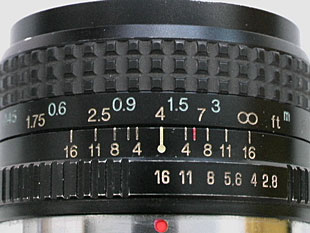
I can't tell you how many times I have heard the phrase, if you are shooting an interview and you back up your camera and zoom in your lens putting the person back into the same frame, you will decrease the depth of field making the background softer. Or simply, if you double your lens length and create the same shot you'll shorten your depth of field. I have heard this from first time movie makers all the way up to very experienced 25 year directors of photography. And there you have one of the greatest misconceptions involving depth of field. Even so, many textbooks print it to this day.
Let me quantify the statement and perhaps you will see where the problem comes from. If you are shooting an interview but the background looks too sharp and you back your camera up and zoom into your person again keeping them the same size as you did when the camera was closer while keeping the same f-stop on your lens, THE PERCEPTABLE DEPTH OF FIELD DOES NOT CHANGE. You don't believe me? But then why does the background appear to get softer? I'll explain and tell you ways to make the apparent softness of your background work in your favor.
Before I go any further, let me show you four photos to demonstrate what I just said.
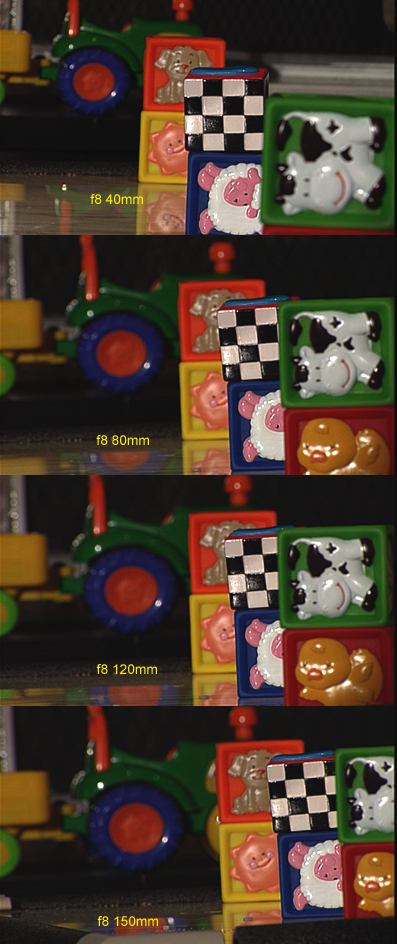
So what am I demonstrating here? First let me say that in all four photos, the camera F-stop is identical (f8). And in all the photos, the cube with the black and white cross-hatch is what I am focused on. The difference between all four photos is merely the focal length (how much I am zooming) the lens. The idea of each photo is that I am keeping the cube in focus relatively the same size in each shot.
First I set up my four objects (three cubes and a tractor) so that each was about 15 inches a part. I then placed the camera about 5 feet in front of the first cube and zoomed into 40mm's on my lens making the first image you see. I then physically moved the camera back and zoomed in again making the image the same size as it was in the first photo. In the second shot that translates to 80mm's. And then I did it two more times until my camera was about 20 feet away and my longest lens in the last picture ended up being 150mms. I did not keep my focal lengths perfectly scientific for a point; regardless of the focal length, if my iris remains the same and my subject remains the same size in the frame, my depth of field remains the same, no ifs ands or buts.
All the other items remain in the same focus plane as they do in any other shot except for the first shot where my first cube was physically at the edge of the forward depth of field of the lens so started to blur. If indeed using a longer lens made the background softer in this case then in each of the four shots, the tractor would be more or less in focus depending on the length of the lens. And more importantly, based on the misconception that changing the lens length will affect the DoF in this situation, the wider lens should offer more depth of field than the longer lens so the background should appear different in terms of apparent sharpness. Just to make sure we are seeing the same thing, here is a shot where I crop the tractor wheel in each shot:

As you can see none is softer than another. In fact, with having a difference of 100mms from the first photo to the last, if the notion that zooming in made a difference in depth of field and softened the background then one would expect the difference to look more like this simulation:
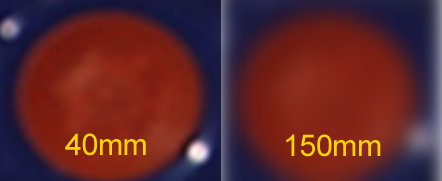
But it is not. In order to create the illusion above, I had to blur the second image in Photo Shop. If the depth of field was affected the tire would clearly look different on it's own. It does not! Of course if the distance behind our focus changed considerably, then we would see a blurrier image than we do in our example.
Bottom line: There are two ways of creating Depth of field; by image size and f-stop. So as in our example, if the image size and f-stop are kept constant, the depth of field will be the same regardless of focal length or angle of view.
So now that the myth of zooming in to make the depth of field change is debunked, let's talk about what is happening and how you can use your camera to help extenuate the illusion, or said another way, how can I create the perception of a shallower depth of field?
There are two ways and they involve the relationship of your camera, subject, and background. I often tell folks that when you are in a small room and you want to make the background appear softer, back your camera up as much as possible to create the illusion of a shallower depth of field. But wait? I thought you said that does not change depth of field? IT DOES NOT! I said "illusion of a shallower depth of field". And perhaps that is why for the last forty years folks got it wrong. Since we associate depth of field with things in focus relative to your subject, it is easy to confuse.
I'll use the term "relative background blur" for starters. Background blur with a longer lens has more to do with the degree of magnification and it's effects on focus than anything else. Very simply when you zoom a lens in (higher magnification), you are affecting optics differently than if your lens is wide and you magnify what exists on wider shots. That is why wider shots, even if out of focus look sharper when seen wide rather than when you zoom into something that is out of focus. Or for a field experiment, try this: Set up your camera and zoom into an object in the distance. Now put it slightly out of focus. Now zoom out. While the shot is technically out of focus because the objects in the frame are smaller, the illusion is that the focus seems sharper on the wide shot or at least much more tolerable than it does with a tighter shot of the object.
So let's look at two ways of creating a blurry background. When would we get to this point? When we have set up our shot and the iris on our camera is as wide as possible but we still want more. I say that because one key factor in depth of field is iris. The wider the iris the shallower the depth of field. But sometimes even wide open you are looking for more.
In most situations I find that my room is smaller than larger, so in that case I suggest folks keep their talent closer to the background (at least five feet away) and back the camera up and zoom in. Look at this shot below which is 40mm's:
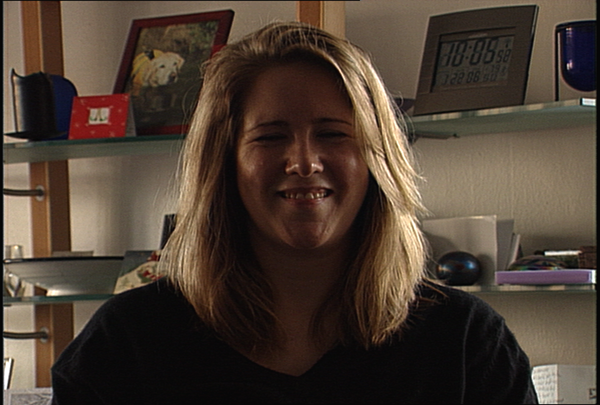
I have not used anything but natural light in the shot above so that we may concentrate on our background. My lens will always be at the same f-stop in all of the following examples.
Now take a look at this shot which is the camera backed up and her head framed to the same size (lens now 80mms):
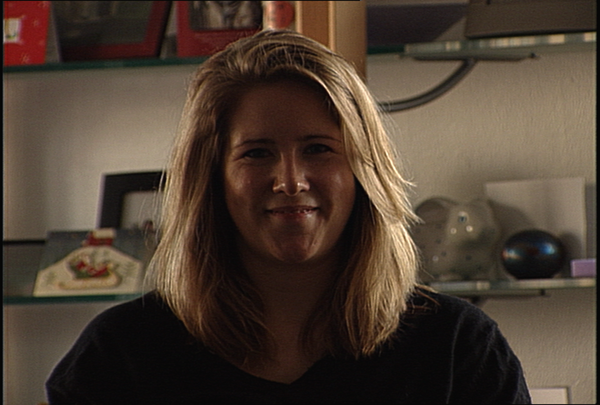
As you can see with the lens zoomed in, the second shot makes the background appears softer. Lets see them side by side:

As you can see the shot on the right which is the 80mm shot compared to the 40mm on the left looks like the background is softer in appearance. The depth of field is the same but the fact that the background is larger looking in the shot one the right means you see a more magnified version of what is out of focus just as much in the shot on the left. It's an illusion that the background is more out of focus.
Let's look at the blue globe over her camera right shoulder in both shots to show that indeed both backgrounds are equally as soft. Of course as that distance from our person to background increases, eventually we will effect the blur even more, but in this example, we don't change the distance enough to really notice.

Look at the balls here and then look at the shots of the talent above. One ball looks softer in her head shot on the right (80 mm) but it is not as demonstrated in the close up of the balls.
As you can see, other than the fact that my framing of the shots between the 40 and 80mm frames was not perfect (both showing her in identical size), the depth of field did not change so the balls are not any different but overall the apparent blur of the background did. As I said one factor that comes into play here is that in the 40mm shot the objects are smaller in the background so you do not see the actual softness of the background as easily. In the 80mm shot the lens shows the background as larger and hence shows the apparent softness better. In other words the perspective of the background changes and that creates an illusion that the depth of field changes. It does not.
So in a situation where you have a small room but want more of a softer looking background, moving the camera back and zooming in shows the actual blur of the background better than a shot where the background is not zoomed in.
It also works well with a wide lens when you have a larger room to work with:
In this case below I have moved the subject 10 feet from the back wall and framed her normally. As you can see the background has nice soft appearance.
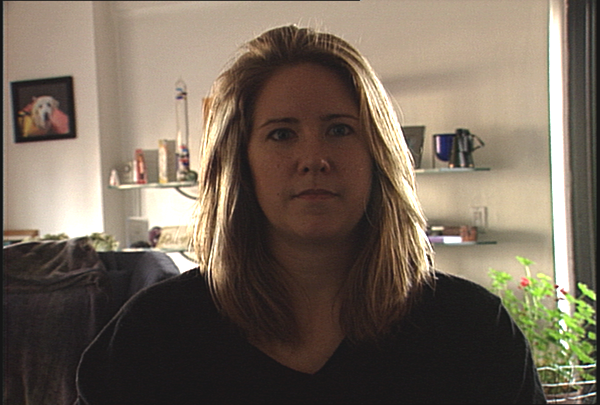
And below I have simply backed the camera up from her (she is still 10 feet from the wall) and zoomed in to make her the same size. Doing so makes the background appear even softer. In fact if you can move your talent further away from the background and zoom in you will find it makes the background appear softer than putting the talent closer to the background and simply backing the camera up and zooming in.
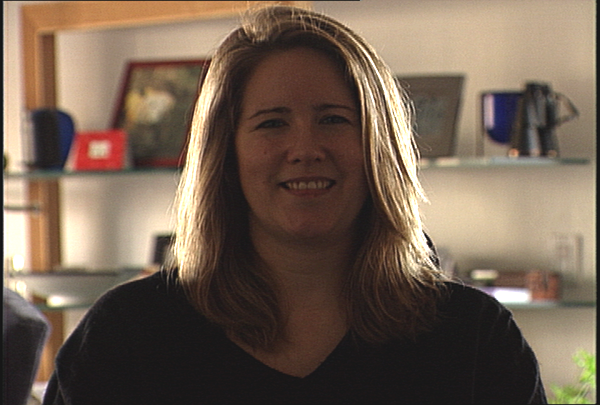
Both methods (zooming in and/or moving your subject and camera away from the background and/or combinations of both) create the illusion of a softer looking background. My advice would be to experiment and find out which works best for you.
In what is considered the bible of cinematography, "A Hands-On Manual for Cinematographers", David Samuelson states at the conclusion of his section on depth of field : "Depth of field remains the same, regardless of lens focal length, so long as the image size (and f-stop) is the same. There is no point in changing to a shorter focal length lens and moving closer, because if the image size remains the same so will the depth of field." (Focal Press, London, second edition, 1998, p.218)
Copyright 2013 by Walter Graff. This article may be circulated and shared as long as the following reference is made: 'This article appears courtesy of Walter Graff- http://www.waltergraff.com'
Please don't hesitate to send me an e-mail if you have any questions or comments please e-mail me at Walter@waltergraff.com